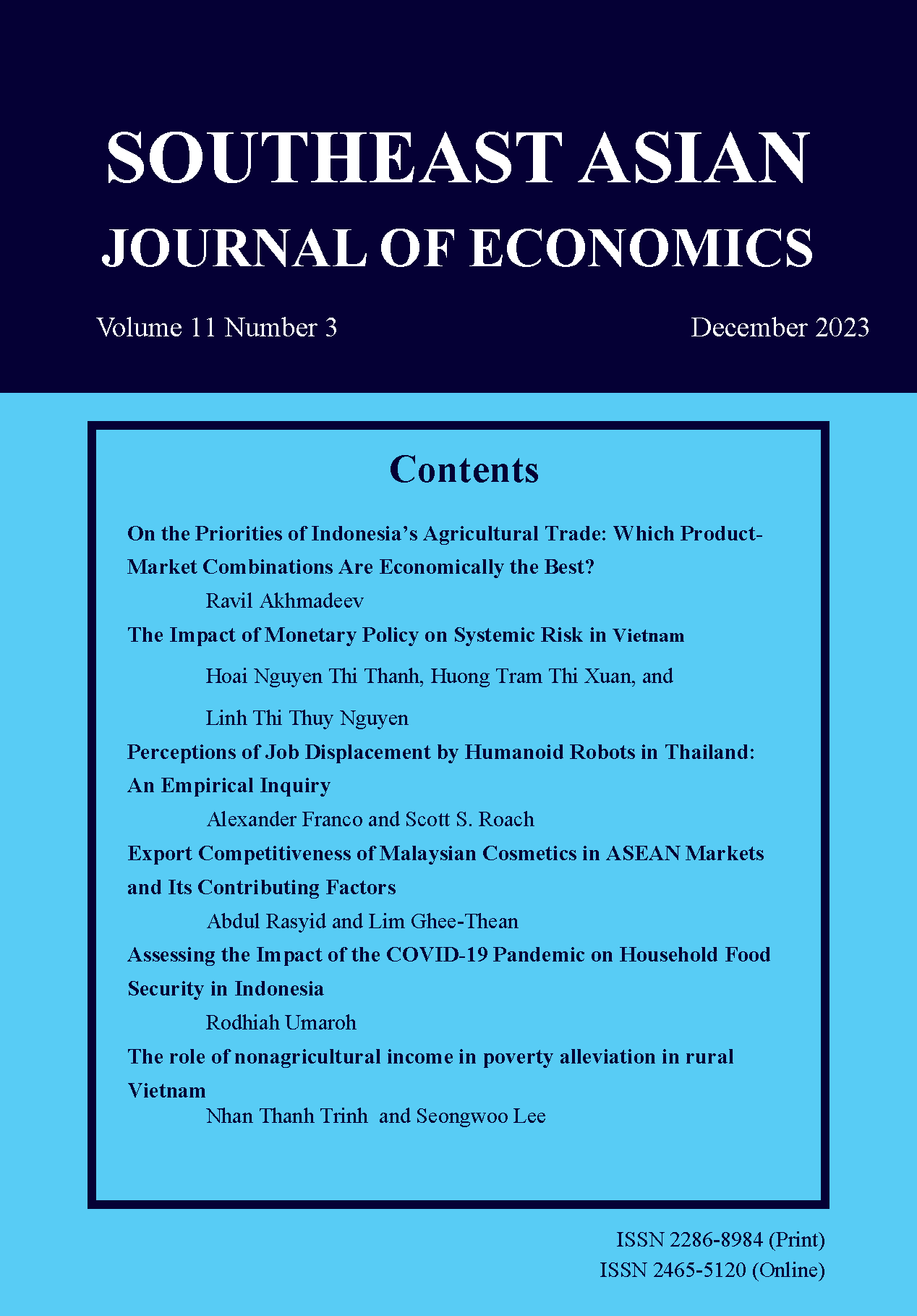Perceptions of Job Displacement by Humanoid Robots in Thailand: An Empirical Inquiry
Keywords:
artificial intelligence, automation, humanoid robots, job displacement, ThailandAbstract
The phenomenon of job displacement by robots, in general, and potentially by humanoid robots has generated a growing body of academic literature as well as studies from business-funded think tanks. Because of the infancy of its development as a technology, much of the literature on humanoid robotics is speculative, focusing mostly on psychometric factors regarding receptivity and not on workers’perception of job displacement or human-robot interaction in future workplaces. This economics study regarding future employment trends is an original, pioneering effort in examining the perceptions of job displacement and future human-robot work interaction in Thailand. It surveyed students in an English-medium MBA program at an international university in Bangkok, Thailand. Perceptions of job displacement were examined using the demographic variables of gender, age, employment status, and ethnic background. The study found partial support regarding all fourof the demographic variables studied, with more significant differences regarding gender and ethnicity.
References
Acemoglu, D., & Restrepo, P. (2019). Automation and new tasks: How technology displaces and reinstates labor. Journal of Economic Perspectives, 33(2), 3-30.
Alemi, M., & Abdollahi, A. (2021). A cross-cultural investigation on attitudes toward social robots. Iranian and Chinese university students. Journal of Higher Education Policy and Leadership Studies 2(3), 120-138.
Autor, D., & Salomons, A. (2017). Robocalypse now: Does productivity growth threaten employment? National Bureau of Economic Research.
Behling, O., & Law. K. S. (2000). Translating questionnaires and other research instruments: Problems and solutions. SAGE.
Bhapkar, P. (2021, September 17). Top 10 humanoid robotics companies. Retrieved from https://www.passionateinmarketing.com/top-10-humanoid-robotic-companies.
Biba, J. (2022). Top 20 humanoid robots in use right now. Builtin. Retrieved from https://builtin.com/robotics/humanoid-robots
Brynjolfsson, E., & McAfee, A. (2011). Race against the machine: How the digital revolution is accelerating innovation driving productivity, and irreversibly transforming employment and the economy. Digital Frontier Press.
Brynjolfsson, E., & McAfee, A. (2014). The second machine age: Work, progress, and prosperity in a time of brilliant technologies. W. W. Norton & Company.
Castelo, N., & Sarvary, M. (2022). Cross-cultural differences in comfort with humanlike robots. International Journal of Social Robotics 14, 1865-1873.
Chinese Cultural Connection. (1987). Chinese values and the search for culture-free dimensions of culture. Journal of Cross-Cultural Psychology 18(2), 143-164.
Contreras, C. (2022, October 9). 10 humanoid robotic companies to look out for. Retrieved from https://www.robotics247.com/article/10_humanoid_robotic_companies_to_look_out_for.
Dahlin, E. (2019). Are robots stealing our jobs? Socius: Sociological Research for a Dynamic World, 5, 1-14.
Domyei, Z., & Taguchi, T. (2009). Questionnaires in second language research: Construction, administration, and processing (2nd ed.). Routledge.
Ford, M. (2015). Rise of the robots: Technology and the threat of a jobless future. Basic Books.
Franco, A., & Roach, S. S. (2017a). Factors that determine accounting anxiety among users of English as a second language within an international MBA program. International Journal of Learning, Teaching and Educational Research 16(1), 22-37.
Franco, A., & Roach, S. S. (2017b). Perceptions of consumers in Thailand towards purchasing products made in China: An empirical study of an international university in Thailand. ASEAN Journal of Management & Innovation 4(1), 78-96.
Franco, A., & Roach, S. S. (2022). Colorism as a Catalyst for the Skin Whitening Industry in Thailand: An Empirical Study. Lambert Academic Publishing.
Frey, C. B., & Osborne, M. A. (2017). The future of employment: How susceptible are to jobs to computerization? Technological Forecasting & Social Change 114, 254-280.
Holmes, H., & Tangtongtavy, S. (1997). Working with the Thais: A guide to managing in Thailand. White Lotus Company, Ltd.
International Federation of Robots. (2017). The impact of robots on productivity, employment and jobs. International Federation of Robotics.
Kamide, H., & Arai, T. (2017). Perceived comfortableness of anthropomorphized robots in U.S. and Japan. International Journal of Social Robotics 9, 537-543.
Komin, S. (1990). Culture and work-related values in Thai organizations. International Journal of Psychology 25(3-6), 681-704.
Krageloh, C. U., Bharatharaj, J., Kutty, S. K. S., Nirmala, P. R., & Huang, L. (2019). Questionnaires to measure acceptability of social robots: A critical review. Robotics 8(88), 1-14.
Krejcie, R. V., & Morgan, D. W. (1970). Determining sample size for research activities. Educational and Psychological Measurement 30, 607-610.
Market Trends. (2022). Top 10 companies working in the development of humanoid robots. Retrieved from https://www.analyticsinsight.net/top-10-companies-working-in-the-development-of-humanoid-robots.
Mendes, M., & Akkartal, E. (2010). Comparison of ANOVA F and Welch tests with their respective permutation versions in terms of Type I error rates and test power. Kafkas Universitesi Veteriner Fakultesi Dergisi 16(50), 711-716.
Morikawa, M. (2017, May). Who are afraid of losing their jobs to artificial intelligence and robots? Evidence from a survey. RIETI Discussion Paper Series (17-E-069), 1-21.
Schwab, K. (2017). The fourth industrial revolution. Century.
Suntaree, K. (1990). Psychology of the Thai people: Values and behavior patterns. Research Institute of Development Administration.
Zion Market Research. (2022, May 17). Demand for global industrial robotics market size & share is expected 11.8% CAGR rise, will hit to USD 81.4 billion globally by 2028 (with COVID-19 analysis. Retrieved from https://www.prnewswire.com/news-releases/demand-for-global-industrial-robotics-market-size--share-is-expected-11-8-cagr-rise-will-hit-to-usd-81-4-billion-globally-by-2028-with-covid-19-analysis--industry-trends-value-analysis--forecast-report--zion-market-resea-301549130.html
Downloads
Published
How to Cite
Issue
Section
Categories
License
Copyright (c) 2023 SOUTHEAST ASIAN JOURNAL OF ECONOMICS

This work is licensed under a Creative Commons Attribution-NonCommercial-NoDerivatives 4.0 International License.
The submission of a manuscript implies that the paper is an original work and has not been published elsewhere. The author(s) authorize the journal to reproduce or distribute the paper in printed or other electronic forms.







